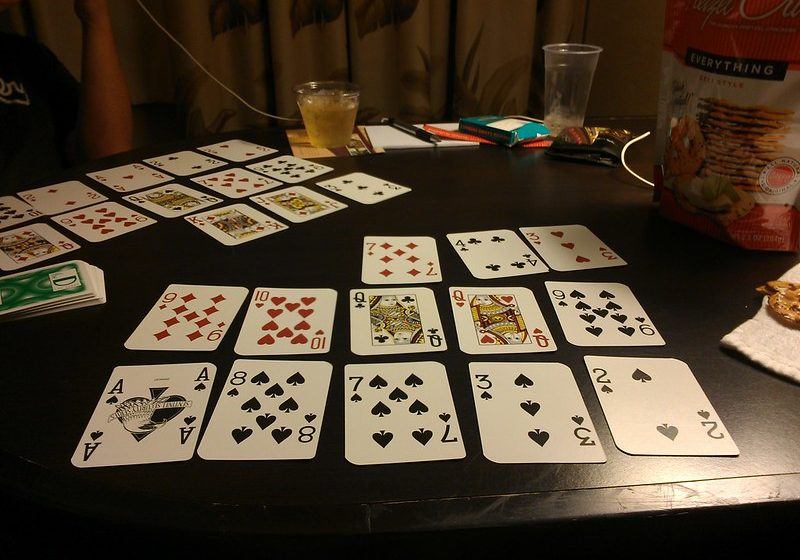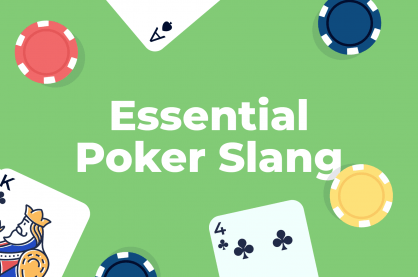What Is Chinese Poker? Chinese Poker Rules & Scoring Explained

What do all poker games have in common? Extreme attention to hand rankings.
Especially Chinese Poker – if you can understand the basic hand rankings, you should be able to succeed in this fast, fun variant.
Note: Chinese Poker is more luck-based than other forms of poker such as Texas Hold ‘Em or Omaha. It’s quick and breezy, and skips over all the typical betting rounds and funky terms such as “flop,” “turn,” and “river.” Also, no poker face required!
How To Play Chinese Poker
Chinese Poker is played with a minimum of two and a maximum of four players. Each player begins by being dealt 13 cards face down. They must then arrange these cards into three separate hands: the back hand, the middle hand, and the front hand.
- This is the only round.
- There is no betting.
- There is no people reading or searching for “tells”.
If you do want to gamble for real money, you would need to place your bets before each player is dealt their 13 cards. For example, whoever wins gets $10! You would need to wager before seeing your cards.
Now let’s talk about the three hand arrangements, which is how to play Chinese Poker in a nutshell. The three Chinese Poker hand rankings are as follows:
- Back Hand (can also be known as the bottom or rear hand): The back hand must contain 5 cards and be stronger than either the middle hand or the top hand.
- Middle Hand: The middle hand must also contain 5 cards but it must be weaker than the arranged back hand and stronger than the front hand.
- Front Hand: The front hand will contain the final 3 cards and it must be the player’s weakest hand of the 3 arrangements.
These arranged holdings must follow this specific hierarchy: the back hand being the strongest 5 card hand of the 3 arrangements, followed by the 5 card middle hand which must be weaker than the back hand and stronger than the final front hand. The front hand itself must consist of 3 cards only.
Here are the Chinese Poker hand rankings displayed in a different way (just to make things easier!)
- Back hand = strongest
- Middle hand = 2nd strongest
- Front hand = weakest
What If I Make A Mistake?
Uh-oh – let’s say you didn’t arrange the hands in accordance with the hierarchy (ex. Your middle hand is the strongest). That’s a penalty! This is considered a foul or miss-set and all your hands will be effectively rendered dead.
You will automatically lose and, yes, receive penalty points too (more on Chinese Poker scoring in the next section).
This is a common way beginners get tripped-up when learning how to play Chinese Poker. Be careful and pay extra attention.
Who Wins?
Once all players have arranged their cards, everyone reveals their hands by flipping them over. Each hand is then compared with each opponent’s corresponding hand (back vs. back, middle vs. middle, and front vs. front). The winner of each comparison is scored, and the player with the highest total points wins!
Chinese Poker Scoring – The Basics
Scoring in Chinese Poker centers around the ‘point’ system. This is very different from other poker variants where you bet chips each round. Instead you can decide on a monetary value – such as ‘one dollar = 1 point.” These points are then settled-up for cash value at the end of the game.
How do you earn points? Winning a comparative back vs back, middle vs middle or front vs front hand versus a single opponent will usually win a player one point in most Chinese Poker scoring systems.
So, if I won the back and middle hands but you won the front hand, our score would be 2 points vs. 1 point.
Another way to execute your own Chinese Poker scoring is by wagering a certain amount – let’s say $10 – and playing winner-takes-all.
Whoever wins the most points simply wins the full amount set aside.
Chinese Poker Scoring – Special Cases
There are special circumstances where Chinese Poker scoring changes – namely surrenders and bonus points. Here’s what I mean:
Choosing To Play Your Hand Or Surrender
In Chinese poker, it is common to give each player the option to announce (in turn with the action moving to the left) if they wish to play or surrender their hand before the top, middle, and back hands are set and revealed.
If a player decides his 13 cards can only produce weak back, middle, and front hands that are very likely to be second best vs his opponents, then the player can decide to “surrender” rather than play their hand.
Surrendering comes with a price. This will often incur a penalty fee somewhere between the 2-3 points they would almost certainly lose if they chose to play their hand and it went to a showdown. 2.5 points in this instance would be typical.
The benefit to surrendering a weak hand in a Chinese Poker scoring system is damage control — it is better to lose 2.5 points than to likely lose 3 points plus the potential 3-point sweep penalty and all the royalties that may apply also.
Royalties (Bonus Points)
In addition to basic single point scoring and surrendering, variations of Chinese poker frequently offer bonus points for players that make specific strong hands. These bonuses are known as royalties. While they can vary, here is an example of what a typical format might be:
Note: the amount of bonus points change depending on which arrangement these hands are made.
- Back Hand:
- Royal Flush: 25 points
- Straight Flush: 15 points
- Four of a Kind: 10 points
- Full House: 6 points
- Flush: 4 points
- Straight: 2 points
- Middle Hand:
- Royal Flush: 50 points
- Straight Flush: 30 points
- Four of a Kind: 20 points
- Full House: 12 points
- Flush: 8 points
- Straight: 4 points
- Front Hand:
- Three of a Kind: 9 points
- High Pair (Aces): 2 points
With these royalties, double points are allocated for the middle hand vs the back hand. This is because the back hand must always form the strongest of the three hand arrangements — therefore making a very strong hand like a straight flush in the middle hand is much more difficult to attain.
Winning Outright
Another need-to-know concept is winning outright. If any player makes three flushes or three straights, they will outright be declared the winner — and collect three points from each opponent that hasn’t surrendered their hand. It’s a sweep!
(As with many of the rules in Chinese Poker scoring, this is also normally agreed on by the players in advance.)
Remember that each player’s back, middle, and front hands play against each individual opponent. Each player must compare their hands separately. Imagine here that we are Player 1 in a four-player Chinese Poker game. Our scorecard might look as follows:
| Hand Number | Player 2 | Player 3 | Player 4 | Win/Loss |
|---|---|---|---|---|
| 1 | +2 | +1 | +3 | +6 |
| 2 | -1 | +3 | -3 | -1 |
| Totals | +1 | +4 | 0 | +5 |
In this example we would be owed 1 point from player 2, 4 points from Player 3, and 0 points from Player 4 after two complete games of Chinese Poker. Using tally ledgers like this makes it easy for each player to see where they are when it comes time to settle up with opponents after the game.
Variations Of Chinese Poker – Open Face Chinese
The most popular variation is Open Face Chinese Poker.
Similar to standard Chinese Poker, the goal remains the same. Each player needs to make a 3-card top, 5-card middle and 5-card back hand arrangement.
Here are the major differences:
- You do not receive all your cards at once.
- You must make your hand arrangements with your cards “face-up” — revealed for all other players to see.
- You act in turns.
So, once you’ve created your hand arrangement, the player to your left will make their hand arrangement next. You do not form your hand arrangement at the same time. Everyone gets a turn that finishes once they declare their hand complete.
Note: You cannot change your hand arrangement after your turn. Your cards are considered “set” and cannot be rearranged. There are no “take backs”!
What makes Open Face Chinese Poker intriguing is that you need to make your hands without knowing which cards are coming next — it adds an element of unpredictability. You are acting with incomplete information.
Since you are drawing unseen cards, it also increases the likelihood of fouls or miss-sets. Open Face Chinese Poker is much more swingy, making it one of the most popular variations of Chinese Poker.
Fantasyland
“Fantasyland” brings an added dimension into any Open Face Chinese Poker game.
To enter Fantasyland, a player must set a pair of Queens or better (e.g., QQ, KK, AA, or any three of a kind) in the top 3-card hand arrangement. All other rows must still be set in proper order — the middle row still must beat the top row. This makes having a pair of Queens or better in your 3-card front hand difficult to achieve… rewarded by the benefit of Fantasyland.
Fantasyland Benefits: After a player qualifies for Fantasyland, in the next hand they will receive all 13 of their cards at once. This allows them to make their back, middle and front arrangements with full information and provides a significant strategic advantage.
- Continuing in Fantasyland: While in Fantasyland, a player can also stay in Fantasyland for subsequent rounds by setting either: four of a kind or better in any row, or three of a kind in the top row.
- End of Fantasyland: If the player in Fantasyland fails to meet the conditions to stay, they return to the normal play mode in the next hand. Fantasyland significantly enhances a player’s chances of making strong hands and potentially sweeping all opponents — a game-changing feature unique to Open Face Chinese Poker.
Conclusion
In short, Chinese Poker is a fast-paced variant of poker that focuses on hand rankings rather than betting and bluffing. The barrier-to-entry and speediness makes it much more beginner-friendly than games such as Texas Hold’Em or Omaha. It’s a quick rush — I’ve even been at poker tables where people play Chinese Poker on breaks!
The core gameplay revolves around creating three hands—back, middle, and front—each with specific strength requirements. Mastering this hierarchy is crucial, as misplacement leads to penalties. Scoring is straightforward, with points earned through hand comparisons, and additional complexity introduced by special cases like surrenders, royalties, and outright wins.
Open Face Chinese Poker kicks things up a notch by revealing cards one at a time and adding the Fantasyland feature, which can give you a big advantage if you play it right.
Whether you’re playing for fun or with real money, Chinese Poker is a more relaxed alternative to traditional poker. It’s easy to learn, quick to play, and combines luck with a bit of strategy — making it a great choice for all kinds of players.
Lead image credit: Jenni Konrad/Flickr, CC BY-NC 2.0


